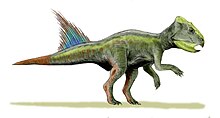古角龙属
(重定向自古角龙)
古角龙属(学名:Archaeoceratops)是角龙亚目古角龙科的一个属,是种基础新角龙类恐龙,生活于下白垩纪(阿普第阶)的中国中北部。古脚龙似乎是种小型的双足恐龙,身长约一米。不同于后期角龙类,古角龙的头盾小,没有角。
| 古角龙属 化石时期:下白垩纪,
| |
|---|---|

| |
| 大岛氏古角龙的想像图 | |
无效状况
| |
| 科学分类 | |
| 界: | 动物界 Animalia |
| 门: | 脊索动物门 Chordata |
| 纲: | 蜥形纲 Sauropsida |
| 总目: | 恐龙总目 Dinosauria |
| 目: | †鸟臀目 Ornithischia |
| 科: | †古角龙科 Archaeoceratopsidae |
| 属: | †古角龙属 Archaeoceratops Dong & Azuma, 1997 |
| 模式种 | |
| 大岛氏古角龙 Archaeoceratops oshimai Dong & Azuma, 1997
| |
| 种 | |
| |
发现及物种
编辑古角龙的化石发现于中国甘肃省马鬃山地区公婆泉盆地的新民堡组[2]。模式种是大岛氏古角龙(A. oshimai),是由董枝明及东洋一在1997年叙述、命名。第二个物种是渔井子古角龙 ( A. yujingziensis ),是由尤海鲁等人在2010年命名。古角龙是该地区第一个发现的基础新角龙类。
古角龙的正模标本(编号IVPP V11114)是一个部分完整的身体骨骼,包含头颅骨、尾椎、骨盆、以及大部分的后脚掌。副模标本(编号IVPP V11115)是一个不完整的身体骨骼,包含保存相当好的尾椎、部分后肢、一个完全保存的脚部,体型比正模标本略小。
分类
编辑古角龙属于角龙亚目,这是一群有着类似鹦鹉喙状嘴的植食性恐龙,生活于白垩纪的北美洲及亚洲。在1997年,董枝明及东洋一将它们分类在一个新的古角龙科之内。
食性
编辑就像其他角龙亚目恐龙,古角龙是植食性恐龙。在白垩纪,显花植物是受地理环境所限制的,所以它们很有可能是以当时最显著的蕨类、苏铁科及松科为食物。它用那锋利的喙状嘴来咬断叶子的。
参考资料
编辑- On a primitive Neoceratopsian from the early Cretaceous of China. Dong, Z. and Azuma, Y. Sino-Japanese Silk Road dinosaur expedition, Dong, Z. (ed). China Ocean press; 68-89 (1997).
- Redescription of neoceratopsian dinosaur Archaeoceratops and early evolution of Neoceratopsia. You, H. and Dodson, P. Acta Palaeontologica Polonica 48 (2); 261-272 (2003).
- Archaeoceratops in the Dino Directory
- ^ You, Hai-Lu; Tanque, Kyo; and Dodson, Peter. A new species of Archaeoceratops (Dinosauria: Neoceratopsia) from the Early Cretaceous of the Mazongshan area, northwestern China. Ryan, Michael J.; Chinnery-Allgeier, Brenda J.; and Eberth, David A. (editors.) (编). New Perspectives on Horned Dinosaurs: The Royal Tyrrell Museum Ceratopsian Symposium. Bloomington and Indianapolis: Indiana University Press. 2010: 59–67. ISBN 978-0-253-35358-0.
- ^ F. Tang, Z. -X. Luo, Z. -H. Zhou, H. -L. You, J. A. Georgi, Z. -L. Tang and X. -Z. Wang. (2001). "Biostratigraphy and palaeoenvironment of the dinosaur-bearing sediments in Lower Cretaceous of Mazongshan area, Gansu Province, China." Cretaceous Research, 22(1): 115-129. doi:10.1006/cres.2000.0242